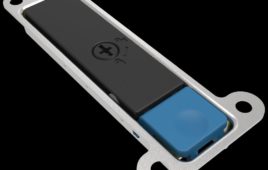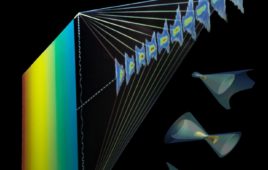Nippon Telegraph and Telephone Corporation (NTT; head office: Chiyoda-ku, Tokyo; president & CEO: Hiroo Unoura), Fujitsu Limited (Fujitsu; head office: Minato -ku, Tokyo; president & CEO: Tatsuya Tanaka), and the National Institute of Information and Communications Technology (NICT; head office: Koganei city, Tokyo; president: Masao Sakauchi) have cooperatively developed the world’s-first compact terahertz wireless transceiver using the 300 GHz band and experimentally demonstrated that it can transmit data at transmission rate of 40 gigabits per second through multiplex transmission using orthogonal polarization.
Since the transceiver can assure a broad frequency band, it is expected to be applied for high-speed wireless communication.
Moreover, in the present development, under a supposed usage case in which large-capacity contents are downloaded from an information terminal (such as downloading video and music), the transmitter of the developed transceiver was installed in such an information terminal. Moreover, according to the results of a contents-downloading experiment using a compact (i.e., smartphone-sized) terminal fitted with a matching developed receiver, data transmission of two gigabytes per second (namely, downloading at a rate of one DVD’s worth of data in about three seconds) was achieved.
Through this experiment, it was shown that a compact transceiver using terahertz waves in the 300 GHz band – as well as the accompanying elemental circuit technology – could achieve large-capacity transmission. From now onwards, it is expected that technologies utilizing terahertz waves in the 300 GHz band will make major advances. The developed technology was presented in detail at IMS2016 (2016 IEEE MTT-S International Microwave Symposium) held in San Francisco from May 22nd, 2016.
Background
As broadband networks continue to spread, investigations on high-speed data transmission via wireless communication are progressing across the world. To attain transmission rates at the level of the several-dozen gigabits per second (which will enable uncompressed realtime wireless transmission of ultra-high-definition images and instantaneous transfer of large-capacity data), it is necessary to utilize presently unused frequency bands. In particular, it is necessary to develop a compact wireless device that can handle high-speed data transfer. Terahertz wireless communication is a promising technology for meeting that need, and utilization of the 300-GHz band (which is presently unused by industry) is expected to open up new frequency resources.
Results of the experiment
(1) Experiment on high-speed data transmission using a compact transceiver for terahertz wireless communication
In this experiment, an InP-based high-electron-mobility transistor (InP-HEMT) was used as an ultrahigh-speed device and incorporated in a high-frequency transceiver circuit designed as an integrated circuit (IC). In this manner, a compact transceiver for terahertz wireless communication using the 300-GHz band was created. The transmitter enables 20-Gbps data transmission as an integrated architecture connecting (via a waveguide) a metal package housing the IC and an antenna . Moreover, under the assumption that the receiver will be mounted in a smartphone-sized terminal, mounting the IC in the antenna-integrated metal package resulted in an overall size of 1 cc (previously reported). The receiver demodulates a 20-Gbps wireless signal (received via the wireless section) and outputs it as a data signal. In addition, as for radiowave propagation and measurement technology concerning the 300-GHz band, high-speed data transfer was verified by an experiment performed in an anechoic chamber.
In this verification experiment, the transmitter and a signal processor for forward error correction (FEC) etc. (both developed by NTT), the receiver (developed by Fujitsu), and the radiowave propagation and measurement technology (developed by NICT) were brought together in the configuration. With the developed transmitter and receiver set facing each other, 20-Gbps data transfer was achieved. As a result, as for transmission distances exceeding 1 m, the possibility of error-free transmission was confirmed.
Furthermore, an experiment on polarization-multiplexing transmission using two transceiver sets and a polarized waves perpendicular to each other was performed, and the results of the experiment confirmed that 40-Gbps data transfer is possible. These experiments confirmed sufficient performance as a wireless device transceiver and the utility of the developed technology.
(2) Verification experiment simulating a data-downloading service
With the developed transmitter installed in an information terminal, and the matching developed receiver installed in a smartphone-sized terminal, a verification experiment simulating a service for downloading data (by touching the smartphone-sized terminal on the information terminal) was performed. In this experiment, video files stored in a PC on the transmission side (i.e., a contents server) were used, and the transfer rate concerning those files was evaluated. As a result, high-speed downloading of data at 2 GB/s (gigabytes per second)–equivalent to downloading at a rate of one DVD’s worth of data in about three seconds–was confirmed. Under the aim of providing a high-speed downloading service, although investigations on using millimeter waves are presently progressing, the effectiveness of using terahertz wireless communication to further increase data-transfer rate was confirmed in this experiment.
Future developments
From now onwards, while further increasing data-transfer rate and improving efficiency of the communication sequence, in anticipation of studies on frequency utilization, we will continue our vigorous investigations on usage cases in addition to contents downloading.
Filed Under: Telecommunications (spectrums)




